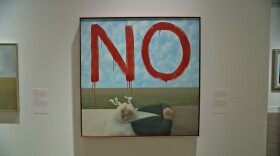The San Diego Underground Film Festival celebrates its fifth year with continued expansion.
The need to rebel is as essential a human quality as is the desire to conform. A showcase of artists who defy expectation, challenge the status quo, and just refuse to be pigeonholed can be found at this year’s San Diego Underground Film Festival (SDUFF).
“We feel underground is any type of media or thing that deviates from the norm that you're being fed through Hollywood, through even regular film festivals,” said Ryan Betschart, lead curator for SDUFF. “We're different. There's a lot of different people that make media and cinema and music that don't fit the commercial qualities be it because it's too weird or too wild or too thoughtful even. It's just more niche and that's underground. Also I feel that ‘underground’ is such a fluid term. Say in 10 years, if the media that we're playing now becomes more accepted then we wouldn't be playing it. Like Marvel films. If Marvel superhero films become more antiquated then the Underground Film Festival will play superhero films in 10 years if that happens.”
That’s not likely to happen but that attitude defines the festival’s personality, it just wants to look to what is outside of the current mainstream and what constitutes mainstream is always changing. Just think about John Waters. His films — like “Pink Flamingoes” and “Female Trouble” — were once considered offensive and unfit for mainstream consumption but by the 1990s he noted, “I realize I’m the establishment now. I mean [Bill] Clinton maybe has seen one of my movies, there’s a president now who possibly could have seen one of my movies.”
So Betschart acknowledges that’s what’s “underground” today may not be in 10 years or maybe not even next year. His dedication to always looking for what is truly underground and out there is what makes the festival so wildly provocative and fun.
Festival Director Rachel Nakawatase added, “So even though we show a documentary it’s also hybrid experimental. Sometimes we have a lot of narratives that also bridge with documentary, experimental, animations and then there are narratives in there too. But you can't really put a finger on just what exactly each type of film is because they crossover several types of genres or mediums.”
And it’s not just a film’s content that is important but also how it was made.
“When a submission is turned into us we look at everything, every aspect of the film including how it was made, how it was funded, the types of people making it, and the types of crew involved,” Betschart said. “It really matters because I feel that what's on the screen can be really informed by so many social situations.”
Nakawatase noted that San Diego is more of a theater town than a film one and she wanted to try and bridge those two communities.
“The immersive aspect of the expanded cinema performances it's just a lot of fun,” Nakawatse said. “So I think that kind of really helps to bridge the gap at least here for our community to show that the live performance aspect and the films’ actual print can kind of merge together to create a really great experience.”
Betschart agreed.
“I feel like that's the future of cinema, the interactive aspect of it." Betschart said. "I read an article that Sundance was looking, because they're getting a new director, they're trying to find someone who can help navigate a less than traditional route for independent cinema. And we feel at San Diego Underground that it's the interactive element — you want to go see something that you can't just see online. You want to go see something that you can't even see in a theater. You want to have the performer, the filmmaker, right there so each performance is new and different, kind of like concerts, like going to see a band. So we have a lot of interactive cinema where people will use projectors and then perform with it.”

One of the performances, “Relict: A Phantasmagoria" by Melissa Ferrari, involves what Nakawatase described as “pre-electricity projection technology, the magic lantern. So that's going to be on Friday night and we’re very excited.”
SDUFF is also hosting world premieres such as “Lacustre,” from San Diego filmmaker Paolo Zuniga who made the film as his for his MFA, “Luzbella,” “Duet” (an animation made by a 17-year-old), and “Origami Tutorial.” There will also be a world premiere of Jonni Phillips’ “The Final Exit of the Disciples of Ascensia,” which is part of her feature film “Wasteland.”

The films represent diversity in terms of age, race, gender, budget, genres, media formats and stories.
“I feel that the underground is so inclusive,” Betschart said. “It's more inclusive than Hollywood. Hollywood's been having an inclusivity problem and the underground is without effort completely opposite of that. It's extremely inclusive of every type of community and person, and you'll see a lot of different types of people. We're playing extremely old white men next to a young teen. And everyone really gets along because it's like a very respectful space and we're super diverse.”
The festival wants to expand its audience and hopes to attract new first-time attendees. If someone feels hesitant that these kinds of films might not be for them or that the sometimes experimental, non-linear and non-narrative format might be off-putting then Betschart suggests thinking about it differently.
“I feel I feel like we experienced non-narrative things all the time,” he said. “If you look at fireworks or parades, you go to Disneyland and they have the electric light parade, and those are all non-narrative. So I think it's a lot more natural than people feel.”
And if you come and don’t like what you see, Betschart encourages you to speak out.
“I think that yes, sometimes we will get people who are very vocal about the things they don't like and we actually don't mind that at all because it really starts a conversation,” Betschart stated. “And that's great too. We really encourage conversation. I actually announced before different screenings that I didn't like a bunch of films that I programmed and it's because you know you don't have to like everything but if it is doing something that like hits you, then it can still be worth seeing. But I think it's just kind of coming in with expectations, which is partially why we call ourselves ‘Underground’ because I think the [term] helps prime people's brains to expect something like, ‘Oh this is gonna be different.’ And then they'll watch it and it's not that all that different, that was cool.”
The San Diego Underground Film Festival runs Thursday through Sunday at the Tenth Avenue Arts Center and you can expect to be challenged and amazed.
You can find a full schedule of films and performances online here.







